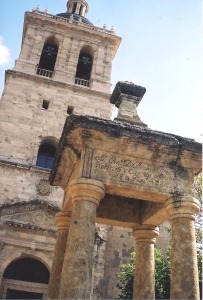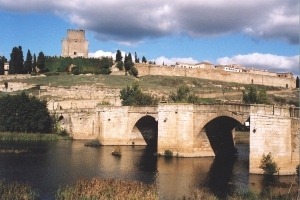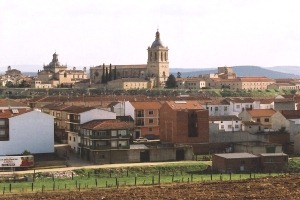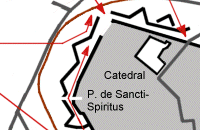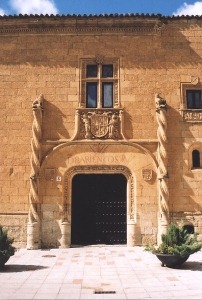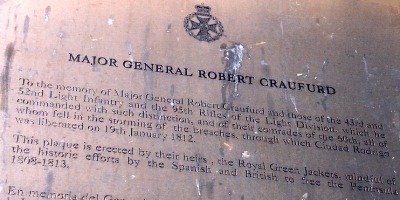
As 1811 drew to a close, shifts in the disposition of French forces in the Iberian Peninsula enabled Wellington to prepare to move against the fortress towns of Ciudad Rodrigo and Badajoz that guarded the invasion routes into Spain; Marshal Auguste Marmont, whose Army of Portugal was based 130km distant from Ciudad Rodrigo at Almaraz, had been ordered to send 10,000 men to support Suchet's assault against the Spanish-held town of Valencia whilst Napoleon was starting to withdraw troops - principally from General Jean Dorsenne's Army of the North - in preparation for his invasion of Russia.
Its weakness however lay in the proximity of two hills - the Lesser and Greater Tesons - the crests of which are only 200m and 600m distant from the northern angle of the town's walls. The Tesons were obvious locations for siege artillery batteries, and it was from here that the French had blown a breach through the angle of the walls in 1810. After capturing the town, the French had strengthened its defences by constructing a fort - the Reynaud Redoubt - on the Greater Teson; it would have to be taken quickly if Wellington's siege was to be successful. On the night of the 8th, and without any preliminary bombardment, ten companies of the Light Division were led by Lt.-Col. John Colborne to within 50m of the Reynaud Redoubt before they were seen. Supported by superbly accurate covering fire, three companies broke into the redoubt by escalade. Within a matter of minutes, the redoubt was captured at a cost of just 25 casualties. Under heavy fire from the town's walls, work was started immediately on the first siege-trench (first parallel). Construction of a second siege-trench (second parallel) leading on to the Lesser Teson began on the night of the 13th/14th. At around 4.30pm on the 14th, three batteries (27 guns) opened fire from the Greater Teson against the northern angle of the town's walls. Owing to a shortage of lime, the mortar used by the French to repair the walls was of poor quality, and the stonework soon began to disintegrate under the impact of the artillery rounds. On the 18th, a fourth battery on the first parallel entered action, targetting the tower which stood where the main road now enters the town; at dusk, the upper part of the tower collapsed forward. By the 19th, breaches had been made both at the northern angle of the walls (the main breach) and at the site of the tower (the lesser breach). Although the breaches were considered practical, both were steeper than could be considered satisfactory. For Wellington, however, time was at a premium, and he ordered the assault to be made on the evening of the same day.
The main assaults against the two breaches were prefaced by a supporting attack made at the south-west face of the town's walls. Shortly before 7pm, the 2nd Caçadores and the Light Company of the 2/83rd led by Lt.-Col. Bryan O'Toole crossed the Agueda river by the Roman bridge, broke into the castle outworks by escalade and captured the two guns which covered the ground in front of the Puerta de la Colada. With these guns silenced, the 2/5th were able to scale the outer wall using ladders, then clear the French as far as the main breach. The frontal assault on the main breach was made by the 94th (from Campbell's Brigade) and Mackinnon's Brigade. Having scrambled to the top of the breach under a hail of fire, the head of the column was confronted by an impracticable 5 metre drop onto ground strewn with sharp entanglements. At the same time, grapeshot ripped through the column from two 24-pounder guns mounted either side of the breach and protected by ditches. The only way forward was to take the guns on directly. On the left side of the breach, men of the 1/88th abandoned their muskets to claw their way across the ditch and up to the gun which they took at bayonet-point. Moving through them, the 2/5th gained a foothold on the ramparts. Across the breach, the 1/45th were able to use abandoned planks to cross the ditch and, braving intense fire, succeeded in capturing the second gun. As the defences gave way, the French detonated a large mine directly under the main breach; Maj.-Gen. Henry Mackinnon was amongst those killed by the blast. At the lesser breach, the Light Division had also broken through, though it was an assault that cost the life of Maj.-Gen. Robert Crauford, fatally wounded at the top of the breach. Elsewhere, the town's defences had been penetrated by detachments under O'Toole and Pack. Resistance rapidly crumbled. The plundering and destruction that followed - regrettable as it was - was largely quelled long before dawn. British and Portuguese casualties from the start of the siege totalled 1,121 killed, wounded and missing of which 562 were accounted for during the storm itself. French casualties totalled around 530 killed or wounded - mostly in the assault - with a further 1,360 unwounded taken prisoner. Wellington now turned his attention towards Badajoz. We were fortunate to stay at the Parador - the former Castle - and more fortunate still to be given one of the rooms from which - as Weller wrote - "one can toss an orange onto the exact position of the two guns taken by O'Toole." Starting from the west side of the Parador, walk in a clockwise direction along the top of the inner ramparts. Approaching the site of the main breach at the north-west corner of the town, there are views towards the sites of the British artillery batteries on the Lesser and Greater Tesons. At the site of the main breach, wide steps lead down past a statue of the guerilla leader Julian Sanchez to the Pl. de Herrasti and the Cathedral. The memorial in the little square commemorates General Herrasti who led the Spanish garrison's valiant - if ultimately unsuccessful - resistance to the French siege of 1810. The side of the Cathedral facing the breach is heavily pot-marked from shell fire. After passing the Cathedral, turn left as if to leave town by the gate Puerta de Amayuelas then turn right into the C. de los Cáceres to see the Palacio de Los Castro where Wellington stayed after the battle. Return to see the plaque to Crauford on the inner wall to the west of the gate. This is the site of the lesser breach. The Tourist Information office is close by.
Pass through the gate and turn immediately left to walk between the inner and outer ramparts. The site of the main breach is very obvious from this vantage point. Continue as far as the parking area outside the Puerta de Sancti-Spiritus. You can return to the Parador from here by passing through the gate and taking the steps to the right. The more intrepid can walk to the Tesons from here. Leave the parking area by the road, then immediately take the path to the right leading downhill. At the main road, cross into the apartment block complex that now stands on the Lesser Teson. Walk straight through the complex towards the ridge on the far side, the Greater Teson. Behind the complex, look forward and to the right to find a recognized crossing point of the railway. Cross the railway here - do take care - and you are on the Greater Teson with fine views over to the main breach from further uphill. Please also take care not to disturb the farmer's crops in this area. "A History of the Peninsular War, Volume V" by Sir Charles Oman, published by Greenhill Books 1996, ISBN 1853672254. "Wellington's Peninsular War" by Julian Paget, published by Pen & Sword 1992, ISBN 0850526035. "Wellington in the Peninsula 1808-1814" by Jac Weller, published by Greenhill Books 1999, ISBN 1853673811. "Peninsular Sketches by Actors on the Scene" edited by W. H. Maxwell, Volume One, published by The Naval & Military Press 2002. Robert Burnham's article on the siege of Ciudad Rodrigo. Map of the siege of Ciudad Rodrigo, 8th-19th January 1812 courtesy of The Napoleon Series. © Andrew C Jackson 2003
|
